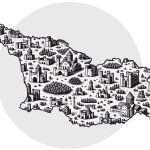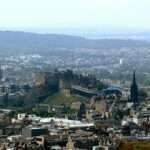Edinburgh is Scotland’s capital city and council area (102 sq mi / 264 km²) known for its UNESCO-listed Old and New Towns (inscribed 1995). Anchored by the Royal Mile between Edinburgh Castle and Holyrood Palace, it blends medieval streets, Georgian planning, universities (founded 1583), and major arts festivals into one compact, walkable city.
Edinburgh at a glance
Edinburgh sits in southeast Scotland, bounded by the Pentland Hills to the south and the Firth of Forth to the north. The city centre rises over volcanic rock, giving dramatic viewpoints and a distinctive skyline. It is the seat of the Scottish Government and Parliament, with royal, legal, and cultural institutions concentrated within a compact urban core.
Population in mid-2023 for the City of Edinburgh council area was estimated at 523,250 (second-largest in Scotland after Glasgow). The council area covers about 102 square miles (264 square kilometres). The Old and New Towns form a single World Heritage Site recognized for the contrast between dense medieval fabric and 18th-century neoclassical planning.
Key facts
| Metric | Value |
|---|---|
| Population (mid-2023) | 523,250 (City of Edinburgh) |
| Area | 102 sq mi (264 km²) |
| UNESCO inscription | Old & New Towns (1995) |
| Royal Mile length | ≈1.12 mi (≈1.81 km) |
| Arthur’s Seat elevation | 251 m (823 ft) |
| Airport passengers | ~15.8 million (2024) |
Sources: National Records of Scotland; Britannica; UNESCO; local guides; VisitScotland; Edinburgh Airport corporate data (accessed Sep 29, 2025).
From fortress to capital — a short history
Human settlement here clusters around Castle Rock, the plug of an extinct volcano. A hillfort known as Din Eidyn prefigured the later burgh; by the 12th–13th centuries, Edinburgh had charters as a royal burgh, and by the 15th century it was recognized as Scotland’s capital. The Old Town grew densely along a ridge, spilling down steep “closes” toward the Nor’ Loch (now Princes Street Gardens).
The Scottish Enlightenment and 18th-century city-building transformed Edinburgh’s identity. The New Town, planned with broad, rational streets and neoclassical squares, became a model for European urban planning—one reason UNESCO inscribed the “Old and New Towns of Edinburgh” in 1995 for their “harmonious juxtaposition.” Today, national institutions (Parliament, highest courts, royal residence) concentrate within walking distance of one another.
Old Town & New Town: why they matter
The Old Town preserves a medieval street plan centred on the Royal Mile; the New Town’s 18th-century grid and crescents express Enlightenment ideals in stone. Together they show two phases of city-making—organic and planned—side-by-side, which UNESCO calls of “Outstanding Universal Value.”
Cityscape & nature — Royal Mile, Arthur’s Seat, and World Heritage
The Royal Mile links two anchors of Scottish history: Edinburgh Castle and the Palace of Holyroodhouse. Although named for a traditional “Scots mile,” the walk is roughly 1.81 kilometres (about 1.12 miles), dropping from the castle’s esplanade to Holyrood. Close-packed tenements, wynds, and closes reveal layers of urban life, while Parliament Square anchors Scotland’s legal institutions.
Just beyond Holyrood Palace rises Holyrood Park and Arthur’s Seat—the city’s outdoor lung—with panoramic views over the Forth and the Old/New Town contrast. Arthur’s Seat is an extinct volcano peaking at about 251 metres (823 feet) and is one of the UK’s most accessible “summits” inside a capital. Trails range from grassy slopes to rocky scrambles; good shoes and weather checks are advised.
Arthur’s Seat & Holyrood Park
For a safe, family-friendly ascent, the eastern approach from Dunsapie Loch is considered the gentlest. The reward: sweeping views across the Firth of Forth, Calton Hill’s monuments, and the gridded New Town. (See the VisitScotland hike overview.)
The Royal Mile spine
From Castlehill to Abbey Strand, the Royal Mile threads together civic, sacred, and royal landmarks—and during August it becomes the theatre of the street itself as Fringe performers busk and flyer. Its geology literally shaped the city: the “crag and tail” left by glaciation created the ridge the Old Town rides upon.
Economy, education & research
Edinburgh’s economy mixes public administration (government and courts) with one of Europe’s strongest financial hubs, plus tourism, tech, and higher education. Recent ONS-based reporting shows the city’s GDP per capita in 2023 at about £69,809—edging London’s—highlighting how high-value services and knowledge sectors drive the capital’s prosperity (interpret with usual city-metrics caveats).
The University of Edinburgh (founded 1583) anchors research strength in medicine, AI, energy, and the humanities. As one of Scotland’s four “ancient” universities and a top-ranked global institution, it shapes the city’s youthful demographics and international ties. In 2025 the university also published uncomfortable findings on historic links to slavery, reflecting a wider UK reckoning with institutional histories.
The University of Edinburgh
Opened on 14 October 1583 under a royal charter from James VI, the university grew with faculties in law (1707), arts (1708), and medicine (1726), fueling the Scottish Enlightenment and the city’s “Athens of the North” reputation. Its campuses are woven through the Old Town and beyond, tying scholarship to place.
Getting in & around — airport, rail, trams, walking
Edinburgh Airport (EDI), about 5 nautical miles (9.3 km / 5.8 mi) west of the centre, handled roughly 15.8 million passengers in 2024 (a record for a Scottish airport), with 37 airlines serving 155 destinations. Rail links at Waverley and Haymarket connect across Scotland and to England, while long-distance coaches and local buses cover regional travel.
The tram network links the airport through the city to Newhaven along the waterfront; a 4.7 km extension opened on 7 June 2023. For visitors, much of central Edinburgh is best on foot: distances are short, gradients can be steep, and historic closes invite detours—so plan extra time. Edinburgh Trams’ Newhaven extension illustrates ongoing investment in low-carbon transport.
Culture & festivals — Fringe, International Festival, museums
Every August, the Edinburgh Festival Fringe—often called the world’s largest arts festival—takes over with thousands of shows. In 2025, around 2.6 million tickets were sold (slightly down on 2024 but still immense), while the International Festival presents curated opera, dance, and classical programmes. Capacity, affordability, and late-night transport remain hot topics as stakeholders seek sustainable growth.
Year-round, the National Museum of Scotland, National Library, and Scottish National Gallery anchor a museum-rich city. At the Royal Mile’s foot, the Palace of Holyroodhouse is the monarch’s official Scottish residence, with “Holyrood Week” events each summer; up the hill, Edinburgh Castle remains Scotland’s most-visited paid attraction, home to the Honours of Scotland and sweeping ramparts over the Old Town. For planning visits, see the Palace of Holyroodhouse and Edinburgh Castle official pages.
FAQ
Is Edinburgh the capital of Scotland?
Yes. Edinburgh has been recognized as Scotland’s capital since at least the 15th century and today hosts the Scottish Parliament at Holyrood, the Scottish Government, and the highest courts.
How long is the Royal Mile and what does it connect?
It’s about 1.81 km (≈1.12 mi), linking Edinburgh Castle at the top to the Palace of Holyroodhouse at the bottom—essentially the Old Town’s spine.
What’s the easiest way to reach Arthur’s Seat?
Many walkers choose the gentler grassy slope from Dunsapie Loch on the east side; allow for changeable weather and uneven ground. Peak elevation is ~251 m (823 ft).
What Did We Learn Today?
- Edinburgh combines a medieval Old Town with a planned Georgian New Town, jointly listed by UNESCO since 1995.
- Population was ~523,250 in mid-2023; the council area covers 102 sq mi (264 km²).
- The Royal Mile runs ≈1.81 km (≈1.12 mi) from the Castle to Holyrood.
- Arthur’s Seat is an extinct volcano rising to about 251 m (823 ft) within city limits.
- As of 2023, reporting of ONS data shows Edinburgh’s GDP per head edging London’s, underscoring a high-value, knowledge-rich economy.





